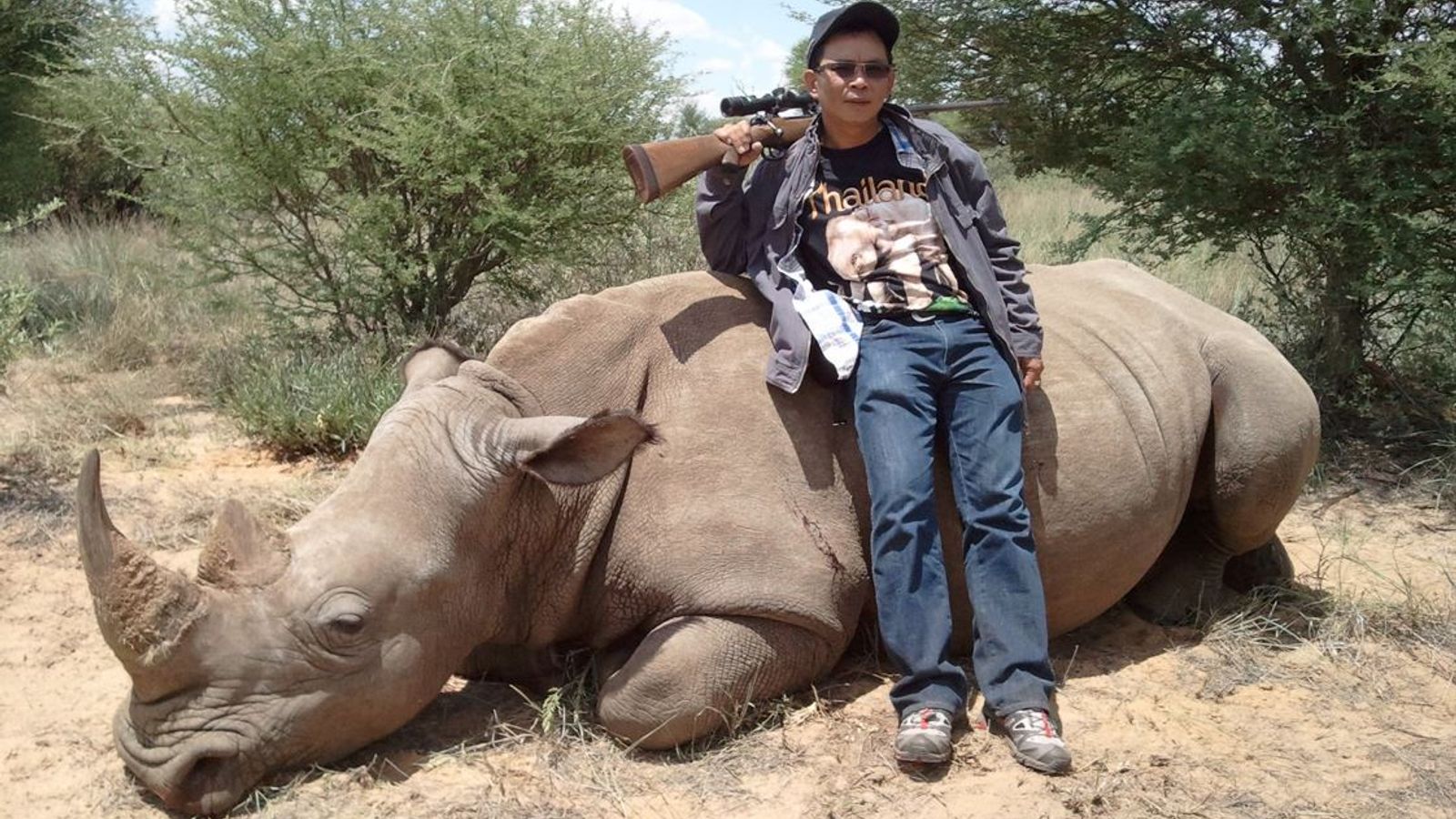It is said to be worth more than its weight in gold, diamonds or cocaine.
The rhino horn trade in Africa and Asia gave rise to criminality and profit on an industrial level, with buyers and sellers making millions.
Steve Galster has made it his life’s work to go after people who brazenly take and sell animal parts.
In 2011, museums and galleries – including some in the UK – reported thefts of rhino horn, with the practice and trade exploding.
As the artefacts dwindled in numbers, live rhinos became the targets, at any cost, in the hunt for profits.
Galster started his career in international security, focusing on wars and insurgencies, but later set up a charity looking into wildlife trafficking.
He says when he scratched the surface of how criminal groups were able to get involved in “pretty nasty insurgencies” in the 1990s, he discovered it came from poaching.
“They just had access to it and there was no real enforcement shield around these animals… it was pretty easy pickings,” Galster tells Sky News.
“Rhinos are pretty easy targets in some countries – that was $65,000 a kilo.
“(Rhino horn is) a small thing to move, you can put that in suitcases. That was super attractive to these groups.”
But why was it fetching such a big price at market?
Many people believe it has medicinal purposes, particularly when it comes to cancer, even though there is no scientific evidence to prove this. Galster says it is often sold as “really expensive aspirin”.
Others hoard it away (in case a relative falls ill) and sell it on later in life as prices rise.
Then there is the art world. Rhino horn is rare, and it’s seen as a status symbol among the wealthy.
‘The Pablo Escobar of wildlife trafficking’
A new Sky documentary focuses on the hunt for a kingpin in Laos who sent his team to take rhino horns from South Africa and smuggle them back through Thailand.
Galster was part of the team that first discovered Vixay Keosavang – dubbed the “Pablo Escobar of wildlife trafficking”.
The US state department said Keosavang was believed to be the leader of the Xaysavang Network, an international wildlife trafficking syndicate which facilitates the killing of endangered elephants, rhinos, pangolins, and other species for products such as ivory and rhino horn.
A reward of up to $1m has been offered for information that leads to the dismantling of the network.
Galster describes going into an “industrial slaughterhouse”, owned by a man known as Fatty who was killing animals such as tigers, bears, and pangolins in Thailand, before driving them to the border to hand them over to Keosavang.
“It felt like sort of a Silence Of The Lambs film,” he says.
“It was basically a farmhouse… we drove up there with all these cars, went in, and we knew there was something weird going on.
“You see these tigers and these bears, and then they’re all hauling out these buckets of body parts. There was a baby orangutan in the freezer. They had turtles, snakes, all kinds of stuff.”
The discovery was part of a chain of events that led them to Chumlong Lemtongthai, who had been hired by Keosavang to hunt for rhino horn in South Africa.
He set up pseudo-hunts, going as far as hiring sex workers for a few hundred dollars and taking them out there, having their names on the documentation and pretending they fired the shots, so the horns could be taken back to Laos.
In South Africa at the time, trophy hunting was legal, but individuals could only shoot one rhino per year – a practice that has now changed.
From there, police and security services tracked and followed Lemtongthai at airports, and were able to prove he was illegally trafficking animal parts from South Africa, back into Laos.
He was given 40 years in South African prison – but was out in six.
‘We’re getting our butts kicked’ by poachers
The practice of wildlife smuggling still carries on.
Galster believes the legal trade is the biggest cause of the illegal trade, saying criminals rely on aspects allowed by law to carry out their own activities and launder the body parts successfully.
“The biggest thing we can learn from this is – let’s halt commercial trade in wild animals,” he says.
“It’s benefiting a tiny percentage of people in the world.
“We can link this trade in some cases to zoonotic outbreaks, so it’s potentially harming a lot of people as well.
“We’re trying to do that – but we’ve run up against some very strong opposition.”
Be the first to get Breaking News
Install the Sky News app for free
Galster says the poachers have global links beyond the likes of South East Asia and Africa, believing the main players have roots in Europe and the US too.
“We’re really behind in this game,” he adds.
“We’re getting our butts kicked. And one of the ways to catch up is to at least pause, if not ban, commercial trade and wild animals, because there’s no way that the current law, wildlife protectors out there can stop this.”
The Great Rhino Robbery will be available on Sky Documentaries and streaming service NOW from 3 January at 9pm.







